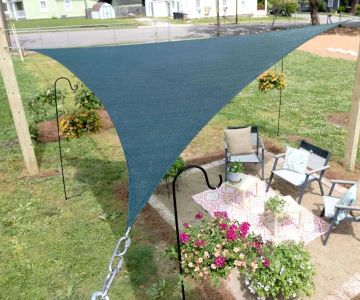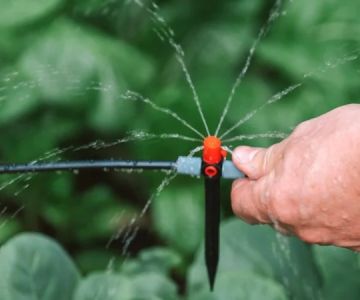
- 1- Why Lawn Fertilization Matters
- 2- Factors Affecting How Often You Should Fertilize
- 3- Best Fertilization Schedule for Your Lawn
- 4- Types of Fertilizers for Your Lawn
- 5- Additional Lawn Care Tips for a Healthy Yard
1- Why Lawn Fertilization Matters
Fertilizing your lawn is essential for maintaining a healthy, vibrant yard. It provides your grass with the necessary nutrients to grow thick, green, and strong, making it more resistant to pests, diseases, and environmental stressors. A well-fertilized lawn not only enhances the curb appeal of your home but also promotes a lush environment for outdoor activities. Regular fertilization helps the grass maintain its vigor and boosts the overall aesthetic of your garden.
2- Factors Affecting How Often You Should Fertilize
The frequency with which you should fertilize your lawn depends on several factors, including:
- Grass Type: Different types of grass (e.g., cool-season vs. warm-season grasses) have different nutritional needs. Cool-season grasses generally benefit from fertilization in the fall and early spring, while warm-season grasses thrive with fertilization in late spring and summer.
- Climate: The weather conditions in your area play a big role in determining when and how often you should fertilize. If you live in a warmer climate, your lawn may require more frequent fertilization during the growing season, while cooler climates may only need a few applications per year.
- Soil Quality: Poor soil with low nutrient levels may require more frequent fertilization to maintain a healthy lawn. If your soil has good organic matter or you’ve added compost, you may need less fertilizer.
- Grass Growth Rate: The growth rate of your grass varies depending on the season. During peak growing periods, your lawn will require more nutrients, meaning more frequent fertilization is necessary.
3- Best Fertilization Schedule for Your Lawn
While the fertilization schedule can vary based on your lawn’s specific needs, here’s a general guideline for maintaining a lush lawn:
- Spring (March to May): This is when your lawn is starting to wake up from winter dormancy. Apply a balanced, slow-release fertilizer to promote healthy growth. For cool-season grasses, this is the best time for the first round of fertilization.
- Summer (June to August): In warmer months, you may need to fertilize again, especially if you have warm-season grass. However, avoid fertilizing during extreme heat as it can stress the grass. If your lawn starts to show signs of nutrient deficiency, a light application of a slow-release fertilizer can be beneficial.
- Fall (September to November): Fall is an important time for fertilizing cool-season grasses to prepare them for winter. A nitrogen-rich fertilizer helps the grass store nutrients to survive the cold months. It’s also a good time to fertilize warm-season grasses as they prepare for dormancy.
- Winter (December to February): Most lawns go dormant during winter, so fertilization is generally not needed. However, if you live in a mild climate, a late fall application of slow-release fertilizer can be helpful to support winter growth.
4- Types of Fertilizers for Your Lawn
Choosing the right fertilizer is crucial for the health of your lawn. Here are the most common types:
- Granular Fertilizers: These are easy to apply and come in both slow-release and fast-release varieties. They provide long-lasting nutrients and are ideal for large lawns.
- Liquid Fertilizers: Liquid fertilizers are fast-acting and quickly absorbed by the grass. They are ideal for addressing immediate nutrient deficiencies but may need to be reapplied more frequently than granular fertilizers.
- Organic Fertilizers: Made from natural materials, organic fertilizers are slower to release nutrients and are often preferred by environmentally conscious gardeners. They improve soil health over time.
- Slow-Release Fertilizers: These fertilizers release nutrients gradually, providing long-term benefits to your lawn. They are excellent for reducing the risk of over-fertilization and nutrient leaching.
5- Additional Lawn Care Tips for a Healthy Yard
Fertilizing is just one part of lawn care. To ensure a beautiful, thriving lawn, consider these additional tips:
- Mowing: Regular mowing is essential for promoting healthy growth. Always mow at the correct height for your grass type, and avoid cutting more than one-third of the grass blade at once.
- Watering: Proper watering is crucial for lawn health. Deep watering is more effective than shallow watering, as it encourages deeper root growth. Water early in the morning to minimize evaporation.
- Weed Control: Weeds compete with your grass for nutrients and water. Implementing a pre-emergent herbicide in the spring and keeping your lawn well-mulched can help prevent weed growth.
- Soil Aeration: Aerating your lawn helps improve soil structure and promotes better root growth. Consider aerating your lawn once a year to reduce compaction and improve water absorption.
For all your lawn care needs, including expert advice and high-quality fertilizers, visit Beautiful Landscapes to find the best products and services to keep your yard looking its best!








 Beautiful Blooms, LLC4.0 (59 reviews)
Beautiful Blooms, LLC4.0 (59 reviews) Tres Potrillos Landscapes5.0 (3 reviews)
Tres Potrillos Landscapes5.0 (3 reviews) Creative Designs Curbing5.0 (2 reviews)
Creative Designs Curbing5.0 (2 reviews) Creative Earthscapes Inc.3.0 (9 reviews)
Creative Earthscapes Inc.3.0 (9 reviews) AN López Landscaping4.0 (90 reviews)
AN López Landscaping4.0 (90 reviews) Buckeye Lawnscape3.0 (10 reviews)
Buckeye Lawnscape3.0 (10 reviews) How to Landscape a Rooftop Garden for Relaxation | Beautiful Rooftop Designs
How to Landscape a Rooftop Garden for Relaxation | Beautiful Rooftop Designs How to Choose the Right Mulch for Weed Suppression: A Complete Guide
How to Choose the Right Mulch for Weed Suppression: A Complete Guide How to Create a Butterfly Pathway Through Your Garden: A Step-by-Step Guide
How to Create a Butterfly Pathway Through Your Garden: A Step-by-Step Guide How to Incorporate Ornamental Trees Into Small Landscapes: A Beginner’s Guide
How to Incorporate Ornamental Trees Into Small Landscapes: A Beginner’s Guide How to Landscape a Front Yard for Maximum Curb Appeal: Expert Tips and Ideas
How to Landscape a Front Yard for Maximum Curb Appeal: Expert Tips and Ideas How to Plan & Build a Backyard Fire Pit Area for Maximum Enjoyment
How to Plan & Build a Backyard Fire Pit Area for Maximum Enjoyment